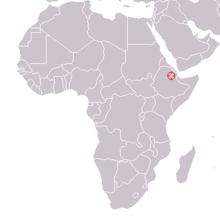User:Shalibalba/Hadar, Ethiopia
| This is the sandbox page where you will draft your initial Wikipedia contribution.
If you're starting a new article, you can develop it here until it's ready to go live. If you're working on improvements to an existing article, copy only one section at a time of the article to this sandbox to work on, and be sure to use an edit summary linking to the article you copied from. Do not copy over the entire article. You can find additional instructions here. Remember to save your work regularly using the "Publish page" button. (It just means 'save'; it will still be in the sandbox.) You can add bold formatting to your additions to differentiate them from existing content. |
Hadar, Ethiopia[edit]
Lead[edit]

In 1972, Taieb organized a small, exploratory reconnaissance of the Afar region to investigate more paleontological finds there. After six weeks of exploration, the party focused on the Hadar site.[1] Hadar is a paleontological site located in the Afar region of Ethiopia, and is the location of important anthropological find "Lucy," a young Australopithecus afarensis female that was discovered in 1974 by Donald Johanson and Tom Gray. The site has yielded a large amount of hominin fossils ranging from the age of approximately 3.42 to 2.90 million years ago. These finds give us a greater understanding of hominin evolution between the years of 3.45 to 0.8 million years ago.
Its postulated that the specimens in the region were deposited by way of a fluvial large river system with associated crevasse channels/splays, deltas, and distributary channels, as well as periodic transgressions of paleolake Hadar located east of the research area (Aronson and Taieb, 1981, Tiercelin, 1986, Campisano and Feibel, in press) possibly related to geological activity or climatic cycles in at least the Kada Hadar Member (Yemane et al., 1996, Yemane, 1997, Campisano and Feibel, in press)."
Hadar Geology
The region consists mainly of mudstones, stiltstones, fine-grained sandstones and volcanic tuffs. The region has been divided into 4 geologic members: Hadar Formation: Basal (∼3.8–3.42 Ma), Sidi Hakoma (∼3.42–3.26 Ma), Denen Dora (∼3.26–3.2 Ma), and Kada Hadar (<∼3.2 Ma) with the three tufts: Sidi Hakoma Tuff (SHT), the Triple Tuff (TT) and the Kada Hadar Tuff (KHT) separating the four members.
The Sidi Hakoma member tends towards high rainfall and low seasonality. The overlying Denan Dora Member was a grassland habitat. Finally, the Kada Hadar Member was an even more open and arid habitat as seen in the high abundance of antilopins, an animal that frequents these types of terrains.[2]
Hadar Specimens and Inferences[edit]
In 1973 and 1974 when the first anatomical discoveries were made, their size and shape pointed towards a variety of taxon present however, further research confirms that there is only one hominin taxon present here. The first find there was a fossil knee joint estimated to have lived 3.4 million years ago. Since then, the Hadar research area has yielded 370 specimens of A. afarensis, one specimen of Homo, and 7571 additional vertebrate specimens.
Based on the specimens recovered, there were a variety of different primitive cranial post features that indicate A. afarensis is distinct from other species of Australopithecus: small cranial capacity, palate similar to African apes (parallel tooth rows, shallow, long from antero-posteriorly, narrow from side to side), primitive occipital, basal cranium anatomy, high frequency of unicuspid third premolars, prognathic face, and primitive mandibular anatomy. Postcranially, the pelvis, knee, ankle and foot indicate habitual, terrestrial bipedalism, but ape-like curved finger and foot bones are retained ancestral ape-like features.[3]
References[edit]
Reed, Kaye E. (2008-06-01). "Paleoecological patterns at the Hadar hominin site, Afar Regional State, Ethiopia". Journal of Human Evolution. 54 (6): 743–768. doi:10.1016/j.jhevol.2007.08.013. ISSN 0047-2484.
Campisano, Christopher J. (2012-03-01). "Geological summary of the Busidima Formation (Plio-Pleistocene) at the Hadar paleoanthropological site, Afar Depression, Ethiopia". Journal of Human Evolution. 62 (3): 338–352. doi:10.1016/j.jhevol.2011.05.002. ISSN 0047-2484.
Johanson, Donald (2017-03-01). "The paleoanthropology of Hadar, Ethiopia". Comptes Rendus Palevol. Des gènes à la culture / From genes to culture. 16 (2): 140–154. doi:10.1016/j.crpv.2016.10.005. ISSN 1631-0683.
- ^ Johanson, Donald (2017-03-01). "The paleoanthropology of Hadar, Ethiopia". Comptes Rendus Palevol. Des gènes à la culture / From genes to culture. 16 (2): 140–154. doi:10.1016/j.crpv.2016.10.005. ISSN 1631-0683.
- ^ Johanson, Donald (2017-03-01). "The paleoanthropology of Hadar, Ethiopia". Comptes Rendus Palevol. Des gènes à la culture / From genes to culture. 16 (2): 140–154. doi:10.1016/j.crpv.2016.10.005. ISSN 1631-0683.
- ^ Johanson, Donald (2017-03-01). "The paleoanthropology of Hadar, Ethiopia". Comptes Rendus Palevol. Des gènes à la culture / From genes to culture. 16 (2): 140–154. doi:10.1016/j.crpv.2016.10.005. ISSN 1631-0683.
